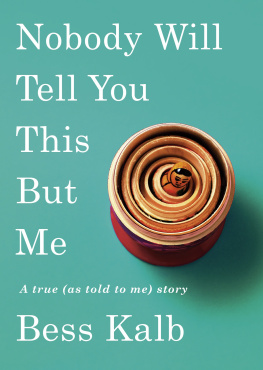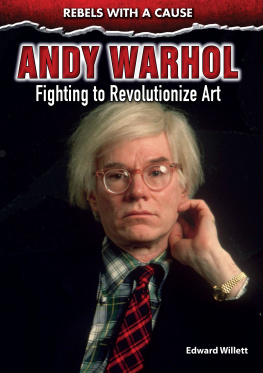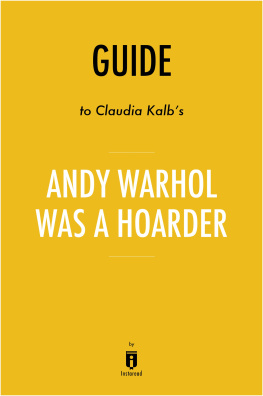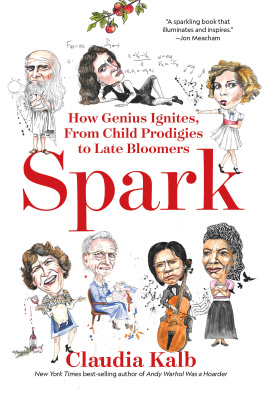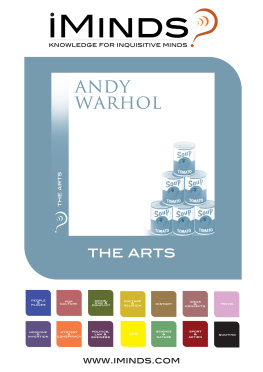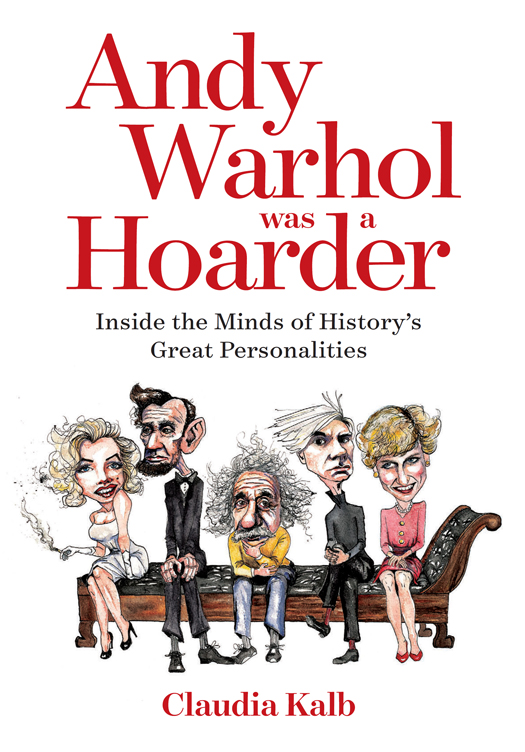Published by the National Geographic Society
1145 17th Street NW, Washington, DC 20036
Copyright 2016 Claudia Kalb. All rights reserved. Reproduction of the whole or any part of the contents without written permission from the publisher is prohibited.
Library of Congress Cataloging-in-Publication Data
Kalb, Claudia.
Andy Warhol was a hoarder : inside the minds of historys great personalities / Claudia Kalb. 1st Edition.
pages cm
Includes bibliographical references.
ISBN 978-1-4262-1466-0 (hardback)
eBook ISBN: 978-1-4262-1467-7
1. Fame--Psychological aspects. 2. Celebrities--Psychology--Biography. I. Title.
BJ1470.5.K35 2016
616.8900922--dc23
2015024370
The National Geographic Society is one of the worlds largest nonprofit scientific and educational organizations. Its mission is to inspire people to care about the planet. Founded in 1888, the Society is member supported and offers a community for members to get closer to explorers, connect with other members, and help make a difference. The Society reaches more than 450 million people worldwide each month through National Geographic and other magazines; National Geographic Channel; television documentaries; music; radio; films; books; DVDs; maps; exhibitions; live events; school publishing programs; interactive media; and merchandise. National Geographic has funded more than 10,000 scientific research, conservation, and exploration projects and supports an education program promoting geographic literacy. For more information, visit www.nationalgeographic.com.
National Geographic Society
1145 17th Street NW
Washington, DC 20036-4688 USA
Your purchase supports our nonprofit work and makes you part of our global community. Thank you for sharing our belief in the power of science, exploration, and storytelling to change the world. To activate your member benefits, complete your free membership profile at natgeo.com/joinnow.
For information about special discounts for bulk purchases, please contact National Geographic Books Special Sales:
For rights or permissions inquiries, please contact National Geographic Books Subsidiary Rights:
Cover and Interior Illustrations: Allison Bruns
15/QGF-CML/1
v3.1
For my parents, Phyllis and Bernard Kalb
And for Steve, Molly, and Noah
With love and gratitude
Introduction
W HY DID A NDY W ARHOL FILL hundreds of boxes with old postcards, medical bills, and pizza crust? What made Marilyn Monroe overdose on sedatives? Why did Charles Darwin suffer from stomachaches, and Howard Hughes insist on turning doorknobs with Kleenex? These are some of the questions that launched this book: a journey into the wonder and anguish of the mind as told through the lives of 12 celebrated figures who reshaped the world. Albert Einsteins theory of relativity transformed our understanding of time and space. Abraham Lincolns Emancipation Proclamation freed slaves. George Gershwins Summertime intoxicated the soul. Almost all of these characters were enormously accomplished in science, business, politics, or the artsbut every one of them also exhibited behaviors associated with a mental health condition like autism, depression, anxiety, addiction, and obsessive-compulsive disorder.
In many ways, historical figures are no saner or zanier than the rest of us. While their public lives have been fodder for books, movies, and splashy headlines, their psyches reveal characteristics that many of us will recognize in our spouses, children, friendseven ourselves. We all craft public personas and tussle with internal dramas. Rich or poor, musician or accountant, boomer or millennial, most of us have something going ona compulsion to line up pencils, a knack for blowing up friendships, an ego that jeopardizes a promotion, a powerlessness over potato chips. I, for one, have been known to triple-check the stove before leaving the house, hang on to old magazines and catalogs, and bawl over sappy commercials. But where is the line between normal behavior and a psychological problem? When is shyness a personality trait, and when is it social anxiety disorder? What makes yanking on your hair trichotillomania rather than just a bad habit? At what point do you treat sadness with Prozac?
Our understanding of mental health has evolved dramatically from the days when our ancestors drilled holes in one anothers brains to excise supernatural possession by demons. Over the centuries, people with psychological ailments have endured a rash of treatments, from leeches to electroshock therapy. Freud, with his theories of unconscious repression, launched the talking cure in the first half of the 20th century; then came the cascade of psychotropic drugs, from the tranquilizer Miltown in the 1950s to Prozac in the 1980s. Today, the brain and the mind are viewed as inextricably linked, and scientists are pushing to pinpoint the biological blueprints of mental health conditions. Intriguing findings are emerging: Activity in a specific area of the brain can predict if a patient with depression will do better with an antidepressant or talk therapy; people with schizophrenia have less brain tissue in the earliest stages of the illness; low levels of oxytocin, a hormone linked to social behavior, have been linked to higher levels of anxiety.
With each new discovery, however, comes the daunting reality that there is so much more to learn. The human brain is infinitely complex and unpredictablea breathtaking mass of tissue comprising some 100 billion neurons and immeasurable capacity. That one organ can power our most basic needs (breathing, eating, walking), foster our intellect, and preside over random thoughts and amorphous feelings is as impossible to fathom as the breadth of the universe. Doctors know far more about the mechanisms underlying heart disease or diabetes than they do about mental disorders, and diagnostic tools are more precise for most physical ailments. X-rays pick up bone breaks; thermometers measure fever; blood tests detect infection. The brain is different. While you can image it for tumors and blood clots, you cannot scan it for bipolar or borderline personality disorders. And even if you could, would you be able to see these conditions with any clarity? Symptoms crisscross and overlap. Boundaries blur. Depression and anxiety often coexist with each other and with other conditions, including addiction, autism, and eating disorders. The notion that mental disorders are distinct entities has begun to change. Researchers recently discovered, for example, that a group of the same genetic variations is associated with five seemingly different conditions: autism, attention deficit hyperactivity disorder (ADHD), bipolar disorder, depression, and schizophrenia.
A mental health assessment is subjective, based largely on what a patients symptoms look like and what he or she tells the doctor. For now, the best that clinicians can do is to compare this against descriptive information and a checklist of symptoms contained in the American Psychiatric Associations 947-page reference book called the


